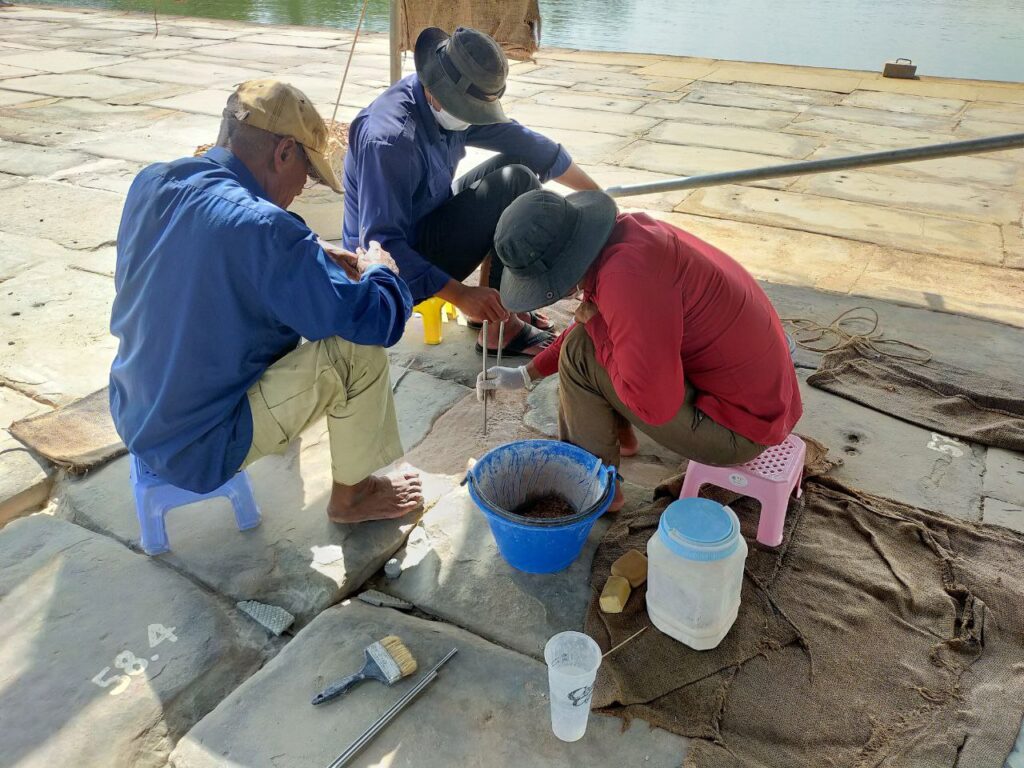ក្រុមការងារនាយកដ្ឋានអភិរក្សប្រាសាទ និងបុរាណវិទ្យានៃអាជ្ញាធរជាតិអប្សរា បំពេញការងារបិតបាយអរ តាមជង្ហុកដក់ទឹក និងចន្លោះថ្មភក់ដែលបាត់ ឬខូចផ្នែកខ្លះនៃកម្រាលស្ពានហាលប្រាសាទអង្គរវត្តឱ្យប្រសើរឡើង បំណងបញ្ចៀសហានិភ័យផ្សេងៗ ពិសេសលើកតម្លៃ ព្រមទាំងសោភ័ណភាពកម្រាលស្ពានហាល ស្របពេលការងារជួសជុលស្ពានហាលប្រាសាទអង្គរវត្ត ជិតរួចរាល់។ បិតបំពេញបាយអរនេះ បញ្ចៀសកុំឱ្យទឹកដក់ធ្វើឱ្យដុះស្លែរ បញ្ចៀសទឹកមិនឱ្យហូរចូលគ្រឹះ នាំឱ្យខូចគ្រឹះរបស់ស្ពានហាល ជៀសវាងគ្រោះថ្នាក់កើតឡើងជាយថាហេតុផ្សេងៗពេលភ្ញៀវទេសចរដើរឆ្លងកាត់។
មន្ត្រីបច្ចេកទេសអភិរក្ស និងជួសជុលថ្ម (ITALIA) នៃនាយកដ្ឋានអភិរក្សប្រាសាទ និងបុរាណវិទ្យា លោក មុំ សុផុន លើកឡើងថា កម្រាលស្ពានហាលធ្វើពីថ្មភក់ នៅផ្ទៃផ្នែកខាងលើមិននៅល្អពេញលេញ១០០ភាគរយដូចដើមនោះ ជ្រុងខ្លះនៃថ្មភក់ពុកផុយ បាក់បែក ខូចខាតដោយអន្លើរៗ បណ្តាលឱ្យមានជង្ហុកខ្លះៗ អាចធ្វើឱ្យក្រឡាច់ឬជំពប់ជើងដួលពេលភ្ញៀវទេសចរដើរឆ្លងកាត់។ លោក សុផុន បន្តថា ការងារនេះធ្វើឡើងតាមដំណាក់កាលៗ និងបានចាប់ផ្តើមតាំងពីដើមខែកញ្ញា គ្រោងនឹងបញ្ចប់នៅចុងឆ្នាំ២០២២ខាងមុខ។ ដំណាក់កាលទី១សម្រេចបានប្រវែងទទឹង៦ម៉ែត្រ បណ្តោយ១០ម៉ែត្រ និងនៅដំណាក់កាលទី២នេះ កំពុងបន្តប្រវែងទទឹង៦ម៉ែត្រ និងបណ្តោយ១០ម៉ែត្រជាបន្តទៀត។
លោក មុំ សុផុន បានឱ្យដឹងទៀតថា វត្ថុធាតុដើមសម្រាប់ផលិតបាយអររួមមានខ្សាច់ ម្សៅថ្មភក់ ម្សៅឥដ្ឋ កំបោរ និងទឹកជាដើម ជាវត្ថុធាតុដើមអាចរកបាននៅក្នុងស្រុក និងមិនធ្វើឱ្យប៉ះពាល់ខូចខាតដល់សាច់ថ្មឡើយ។ ក្រុមអ្នកជំនាញរំពឹងថា ក្រោយបំពេញនៅតាមជង្ហុកនៅស្ពានហាលផ្លូវចូលប្រាសាទអង្គរវត្តរួចរាល់ភ្ញៀវទេសចរអាចដើរឆ្លងកាត់ដោយមានសុវត្ថិភាព ដែលនេះ ក៏ជាផ្នែកមួយដ៏សំខាន់ស័ក្តិសមនិងតម្លៃរបស់ប្រាសាទអង្គរវត្តផង៕
អត្ថបទ និងរូបភាព៖ យី សុថា
APSARA National Authority to fill the mortar in the sandstone joints and gaps at Angkor Wat’s causeway
The restoration team from the Department of Conservation of Monuments and Preventive Archaeology of APSARA National Authority is working to fill the mortar in the sandstone joints and gaps at Angkor Wat’s causeway to avoid any risks, especially to enhance its beautification, while the restoration work of the Angkor Wat’s causeway is almost finished. To fill the mortar in the sandstone joints and gaps to prevent water ponding causing moss to grow, prevent water from flowing into the foundation, damaging the foundation of the bridge, and avoid accidents when tourists pass by.
ITALIA Technical Officer of the Department of Conservation of Monuments and Preventive Archaeology, Mr. Mom Sophon, said that the floor of Angkor Wat’s causeway is made of sandstone, which on the upper surface is not 100% as good as before, and some corners of the sandstone are broken and damaged. Slowly causing some potholes can cause overturning or tripping when tourists pass by. Mr. Sophon added that this work is done in phases starting at the beginning of September and is scheduled to be completed by the end of 2022. The first phase is six meters wide and ten meters long, and the second phase is six meters wide and ten meters long.
Mr. Mom Sophon said that the raw materials for the mortar production, including sand, sandstone powder, brick powder, lime, water, etc. are available locally and do not damage the original stones. Experts expect that after filling in the gaps in the causeway at the entrance to Angkor Wat, tourists can walk through safely, which is also an important part of the value of Angkor Wat.
Article and Photos: Yi Sotha
Share:
Our Latest News

សេចក្តីជូនដំណឹង ស្ដីពីការដាក់ឱ្យប្រើប្រាស់សាកល្បងកម្មវិធី Visit Angkor – 09 May 2025
ដើម្បីទាញយកកម្មវិធីVisit Angkor៖




